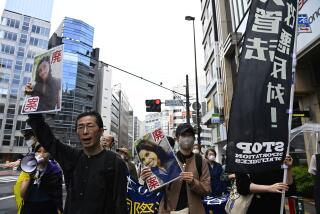A Bureaucratic Hold on Japan : Myth of Ethnic Homogeneity Helps Block Path to Pluralism
- Share via
On Jan. 13, Japanese Prime Minister Noboru Takeshita met President Ronald Reagan in Washington. It was billed by both sides as a U.S.-Japan summit. In reality, it was a photo opportunity and luncheon that produced no substantive discussions of the issues facing the two countries. In fact, to minimize Takeshita’s political exposure, Japanese bureaucrats timed his visit during the congressional recess. They took the chance that the timing of Takeshita’s first state visit could be seen as a slight to Congress. The bureaucrats wanted to avoid any possibility that Takeshita might inadvertently make a statement they did not approve of.
In April, 1986, former Prime Minister Yasuhiro Nakasone met President Reagan in Washington and promised that Japan would open her remaining markets. In Tokyo, however, a middle-level bureaucrat from the Ministry of Foreign Affairs hurriedly repudiated Nakasone’s remarks and told the press corps that Nakasone’s statement had nothing to do with the Japanese government’s position. He excluded the prime minister from the government and got away with it.
All Japanese politicians, from ruling party to the opposition, have become totally dependent on the central bureaucrats for drafting and passing bills. They stage Kabuki plays of “debates” on bills according to scenarios created by the elite bureaucrats of each ministry. Unfettered by the task of governing Japan, Diet members, including the prime minister, are free to devote themselves to influence-peddling, pork-barrel legislation and other deals. Public construction projects, agricultural subsidies and import restrictions are fertile fiefdoms for these politicians and bureaucrats. It is no wonder that they resist opening their protected turfs to competitive bidding and free international competition.
When they retire from their ministry, many bureaucrats become active in politics to further advance their personal interests. Today more than one-third of the Liberal Democrats (the ruling party) in the Diet are former bureaucrats.
How did Japan lose the democratic ideals we adopted from America after World War II? The problem is deep-seated in the Japanese myth of ethnic homogeneity, almost the Japanese religion.
Since 1868, when Japan came out of the feudal era, its Establishment has inculcated the myth of one-race, one-interest through Japan’s formal education system. This myth of a monolithic interest obviated the need for pluralistic politics in which democratically elected politicians balance the diverse interests of various groups. Instead, the central bureaucrats have become the principal arbiters of squabbles among the members of the ostensibly big happy family of Japan.
After World War II, Japan adopted universal suffrage. But Diet seats are still allocated on the basis of the 1947 national census when cities lay in war-torn ruin. Subsequently, when the urban population swelled, farmers’ votes became at least three times as valuable as urban votes. Bureaucrats were quick to hook farmers and their politicians on subsidy addictions, cementing the bureaucrat-farmer alliance’s hold over politics.
The national organization for Japan’s big multinational businesses, the Keidanren, has financially sustained the ruling party and some opposition parties. However, the myth of one-race, one-interest has been so strong that the Keidanren still does not represent the interests of the urban industrialists and their employees versus the interests of bureaucrats and farmers who rule Japanese politics. As long as the world allowed Japan to play export games without concomitant concessions on imports, the interests of big business and their urban employees ran parallel to the interests of the bureaucrats and farmers.
Today, however, behind a robust facade of a growing economy that is fueled by rampant land speculation, about 80% of the people are bearing the burden of heavy taxes and exorbitant prices for housing, land, food, clothing and other products and services whose markets are shielded from foreign competition. The average Japanese earns about the same income as his or her American counterpart. But the Japanese must work almost five times as long to buy one pound of fish, five times as long for one pound of rice, nine times as long to buy one pound of beef, and three times as long for one gallon of gasoline.
Many urbanites have become restless and increasingly aware of their miserable fate. Some consumer mavericks have finally broken the political taboo of opposing the bureaucrat-farmer alliance that keeps Japan totally closed to foreign rice. In 1987, for the first time in Japan’s postwar history, they cut rice subsidies to farmers by about 6%. Last spring, Japan’s city dwellers and businesses successfully revolted against the national sales tax that the bureaucrats had tried to ram through the Diet. These victories are slowly chipping away at the myth of Japan’s monolithic interest and above all at the myth of the “wise and selfless” bureaucrats. Perhaps politicians representing urban areas will begin to press for one-person, one-vote and pave the way for a pluralistic society.
More to Read
Sign up for Essential California
The most important California stories and recommendations in your inbox every morning.
You may occasionally receive promotional content from the Los Angeles Times.












